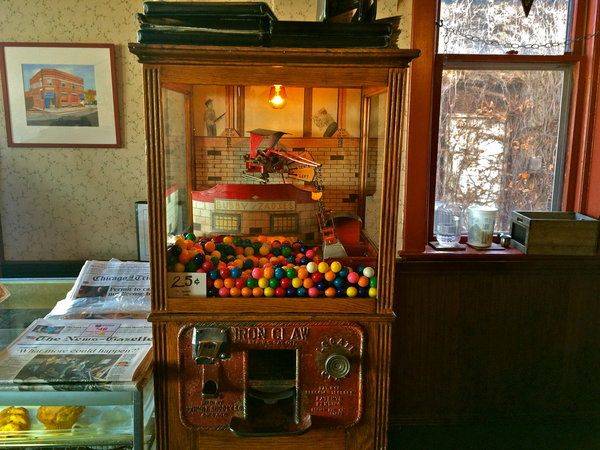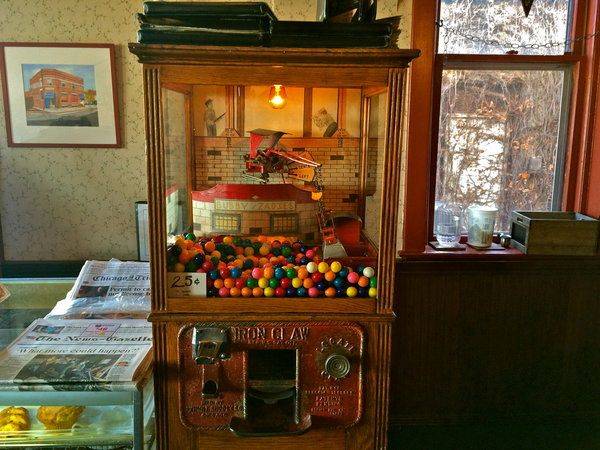 Wondering what Abecedarian is? Look at it as ABCD and on from there. Should you choose to join me, I will be offering a typographically-inspired exploration for 2014 of 26+ objects, events, places, and more that I find compelling in our community.
Wondering what Abecedarian is? Look at it as ABCD and on from there. Should you choose to join me, I will be offering a typographically-inspired exploration for 2014 of 26+ objects, events, places, and more that I find compelling in our community.
Champaign-Urbana is, for the incisive observer, an extraordinary place. It might look on first acquaintance like a “typical small midwestern town” bordered by cornfields, yet do a bit of bumbling around and you can find a remarkable range of delightful and thought-provoking personalities, pursuits, and resources.
Who says we must go in alphabetical order? This gambit will begin as follows.
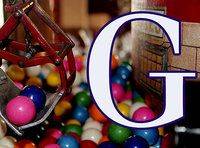 is for Gumball Machine. In residence at the Courier Café since its opening in 1980 is a magnificent Iron Claw Digger, an arcade machine made by the Exhibit Supply Company in Chicago in the late 1920s.
is for Gumball Machine. In residence at the Courier Café since its opening in 1980 is a magnificent Iron Claw Digger, an arcade machine made by the Exhibit Supply Company in Chicago in the late 1920s.
This particular model was acquired back in the 70s from a Chicago antiques dealer by Allen Strong, owner of the Courier, as a collection of loose parts in boxes. He knew the fascination of these arcade attractions and welcomed the challenge of putting it back together.
Strong first installed it in Bubby and Zadies, a delicatessen on the corner of 6th and Green in Campustown that was a popular hangout for locals and students, offering excellent bagels as well as a free lending library. Strong came to CU in 1975 to find a way to support himself before beginning a graduate degree, ended up taking over B&Z’s – and never going back to school. He learned the trade well and moved on to mastermind both the Courier Café and Silvercreek, longtime establishments that anchor downtown Urbana firmly between the local crowd and the campus community.
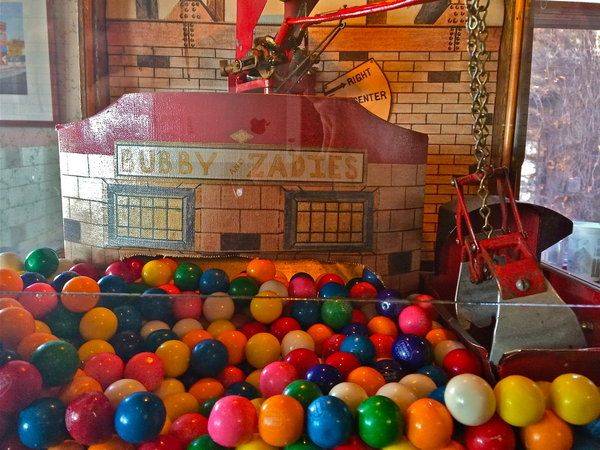
The building that houses the Courier Café was the home of the Courier newspaper, published under different variations on the name between 1877 and 1979. As the Morning Courier, in its last years, it coexisted with The News-Gazette. The Courier was the more left-leaning, and it struggled to maintain its standing alongside the more majority-opinioned N-G. It went out of business in 1979.
So 111 N. Race Street in Urbana was left vacant at the same time that Strong was looking to expand his restaurant. He rebuilt and renovated and added his own personal stamp, as is appreciated by anyone who walks in the door and takes in the tin ceiling, wooden booths lighted by original Pullman lamps, 1915 brass cash register, 1930s-era biplane fan hanging from the ceiling, and, of course, the Iron Claw Digger.
There’s just something about a glass case full of bright round shining gumballs. I have never been tempted to put one in my mouth, but they sure look irresistible. Add to that the exquisite suspense of watching the digger — a miniature mechanized steam shovel — slowly move its gears into action after a quarter goes in the slot, make its meandering way across the terrain of gumballs, open its jaws, and tantalizingly scoop up — none? one? two? I have been, I swear to it, witness to the champion performance of Three Gumballs in One Pass.
The digger jerks its way over to a square chute, empties the load, and the gumballs drop into the hands of the lucky winner.
Iron Claws were not designed to distribute gumballs; that’s just a handy commodity readily available today at any box store. According to James Roller, an early arcade operator and more recent restorer, the machines originated in the 1890s. They were based on a children’s game called the Erie Digger, a hand-cranked steam shovel that the player could manipulate for a penny to capture prizes. The first patent was claimed in 1932 by William Butler for a “coin controlled vending machine.”
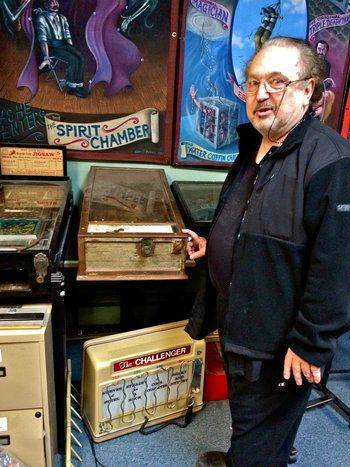 Andy Dallas of Champaign is a longtime admirer of arcade machines and has a number in his collection at Dallas & Co. on the corner of University and First Street, his specialty source of costumes, magic, and more for 38+ years.
Andy Dallas of Champaign is a longtime admirer of arcade machines and has a number in his collection at Dallas & Co. on the corner of University and First Street, his specialty source of costumes, magic, and more for 38+ years.
In the 1970s Dallas operated the Apple Duck Arcade on Green Street with old-style mechanical pinball machines before the electronic variety entered the scene. He showed me an antique slot machine camouflaged as a restaurant napkin dispenser, one outfitted with a side chute for gumballs, and one that hands out matches in addition to playing slots.
The people who designed these machines were creative geniuses, often not schooled. They knew their mechanics; they knew human fascination. They knew what kindles anticipation with the excruciatingly slow speed of these diggers while you watch to see the fate of your investment. There are fascinating slips and drops, swoops and saves, as the claws make their way along whatever that particular machine contains. In the early years of the diggers, it was often corn interspersed with prizes like penknives or candy.
The machines were popular entertainment in the days when people went out for society and fun to arcades, boardwalks, county fairs, even drugstores and hotel lobbies. There was fierce marketing in the sales brochures issued by the Exhibit Supply Company (Full Caps As Shown):
TO MEN OF VISION — we repeat — make yourself independent—in your own business with a good income ON BUSINESS STREET with EXHIBIT DIGGERS.
At fairs and arcades, the machines could be staffed by an operator who knew the transit of his particular set of claws and could control the awards. According to Andy Dallas, prizes were sometimes rigged by being made of lead, much too heavy for the shovel to pick up. The watchful eye of the U.S. government frowned on these deceptions and outlawed diggers as “gambling devices” in 1951 under the Johnson Interstate Transportation Act.
And so for a time the nickel digger business was shut down. Over the next two decades, there were ins and outs in legislation, with various workarounds like requiring that any gambling device also vend something or call for some level of skill.
In 1974 coin slots became legal once again. The digger at the Courier used to have a dime slot. When that broke, Strong could only find a quarter slot – and so, de facto inflation. The machine has broken only four times since he assembled it in 1974; every time he’s fixed it himself.
There is a rich history behind these machines that engages the playful facets of the American character, from engineering wit to the lure of chance, the attraction to bright candy balls, and then the more sinister players in politics and the mob. Today the descendants of the original diggers operate in movie theater lobbies. And then there are the gumball machines that are mere dispensers in restaurants and malls. How dull they are.
I challenge you to find one that approaches the mystique and the magic of the Iron Claw. If you’ve never had the pleasure to see it in action, I’ll stake you to a quarter. Maybe, like me, you’ll be hooked forever.
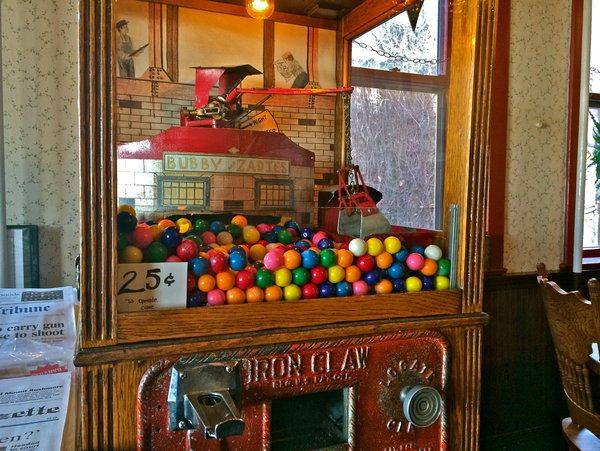
Let’s end with a nod to the letter G itself.
The earliest writing systems date from Mesopotamian cuneiforms and Egyptian hieroglyphs in use as early as 4000 BCE. Our alphabet is a complex evolution of these characters and their descendants, which were formalized by the Phoenicians and then the Greeks into the first “true alphabet,” which requires both vowels and consonants. Semitic characters are immediate antecedents of a number of our letterforms, but not the letter G. That was developed by the Romans specifically to distinguish the sounds “k” and “g”.
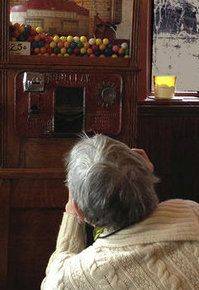 C, which had metamorphosed from the Semitic “gimel,” or camel, into the Greek gamma, was the third letter of the Latin alphabet in 312 BCE when, according to type historian Allan Haley, a crossbar was added inside the counter of C to create G.
C, which had metamorphosed from the Semitic “gimel,” or camel, into the Greek gamma, was the third letter of the Latin alphabet in 312 BCE when, according to type historian Allan Haley, a crossbar was added inside the counter of C to create G.
At that time Z was the 7th letter of the alphabet; but X, Y and Z were not considered necessary to the Romans, and so they were bumped to the end. G then took 7th place in the abecedarian lineup.
And to stimulate some suspense: the next stopping-place in our amble will be the letter U.
Copenhaver Cumpston is a typographer and book designer resident in Urbana. You can find her here.








